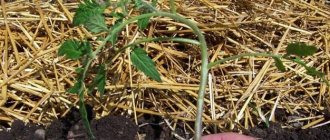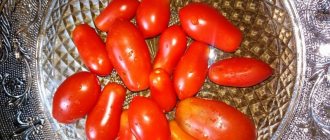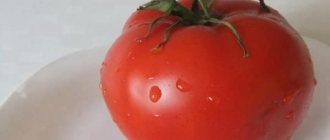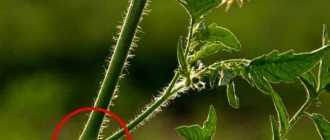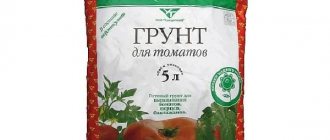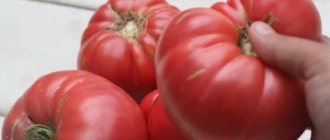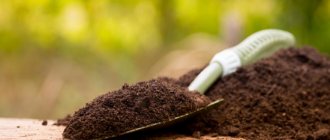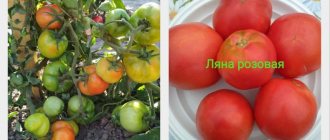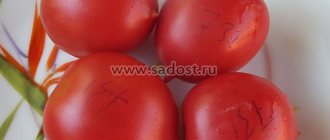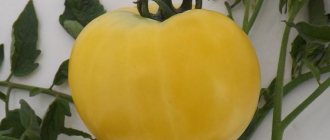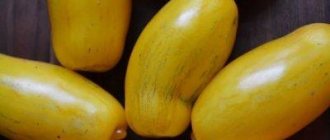The Diorange F1 tomato is valued for its neat, tasty fruits, high level of productivity, and excellent presentation. Designed for growing in garden beds and farms. Fruits well in greenhouses and open areas.
| Height | Landing location | Ripening time | Fruit color | Fruit size | Origin | Fruit shape |
| Medium height | Greenhouse, Open ground | Early ripening | Orange | Average | Hybrid | Flat-round |
Description of the variety "Diorange"
Just like other indeterminates, Diorange tomatoes reach a height of 1.2 to 1.8 m. The variety requires pinching, and the top is pinched after reaching almost maximum growth in order to direct the growth energy to the ovary. "Diorange" shows good results if its bushes are driven into one or two stems. The first inflorescences are formed after the 9th or 11th leaf, further ones - every 2-3 leaves. The fruits grow in clusters, the average number of which on 1 bush is 4-5 pieces. “Diorange” is a distinct early variety, the ripening period of which is 85-90 days from the date of sowing.
The name of the variety says that its fruits have a rich orange color, due to the richness of the fruit in carotene. Tomatoes form a round shape, reaching an average weight of 140 to 190 g. Inside the fruit, 3-4 chambers are formed where seeds grow. The pulp of the fruit is fleshy and dense, which allows this variety of tomatoes to be stored and transported. Based on reviews, the tomato has good taste. The average yield reaches up to 20 kg per 1 sq. m.
The Diorange variety is officially included in the state register of vegetable varieties of the Russian Federation as one that is suitable for cultivation in open and closed ground, by farms and small gardeners. The tomato has performed well in regions of southern and mid-latitudes, while in the north it is grown exclusively in greenhouse conditions.
Description and characteristics of the variety
Tomato Diorange F1 is an indeterminate medium-sized hybrid, the shoot height reaches 1.3-1.5 m.
The bushes are powerful and durable. The foliage and bushiness are moderately expressed. The number of fruiting clusters is in the range of 8-9, each with 4-5 tomatoes.
Description of fruits:
- weight 150-180 g;
- bright orange color;
- transportable;
- shelf life up to 14 days;
- the flesh is fleshy, juicy;
- The skin is dense and does not crack.
Diorange tomato "Semko" has an early ripening period - 90-100 days from germination.
Variety value
According to reviews from gardeners, they value the Diorange variety for its tasty and juicy fruits, which are suitable primarily for fresh consumption and salads, as well as thermally processed culinary dishes. The small fruits produced by this hybrid are suitable for pickling and whole-fruit canning.
Large farmers appreciated Diorange for its high yields, transportability and storage ability. In addition, the original color makes the fruits of this tomato quite popular among the population.
Advantages and disadvantages
The undoubted advantages of Diorange tomatoes include the following characteristics:
- high productivity;
- early stages of reaching ripeness;
- transportability and keeping quality;
- excellent gastronomic characteristics;
- attractive presentation of tomatoes;
- takes root in open and closed areas.
Given the indicated useful characteristics of the variety, no significant shortcomings have yet been identified. At the same time, we should not forget that this is a hybrid, which means that you will not be able to collect the seeds yourself.
Description and characteristics of tomato Diorange F1, reviews, photos
Early ripening , indeterminate (above 1.5 meters) hybrid of tomato.
The bush is medium-sized. The first brush is placed only above the 11th sheet.
Basic qualities of fruits
The tomatoes are round, dense, bright orange in color, weighing 150-180 grams each. They have a good taste, like other hybrids, the fruits are smooth and marketable. Keeping quality is average, up to 14 days.
Diorange tomatoes are not prone to cracking. Sets fruit even in bad summers. Recommended for growing both in greenhouses and in open ground. Garter required.
The hybrid is resistant to major tomato diseases. Productivity reaches 22 kg per 1 sq. meters (with proper agricultural technology).
If you have grown Diorange F1 tomatoes, please leave reviews and photos about them in the comments, this will help you evaluate the tomato and decide whether it is worth planting or not.
You can see other interesting varieties and hybrids of tomatoes with photos, descriptions and reviews in our Tomato Catalog. Enjoy watching.
Agricultural technology varieties
Following the correct technology is aimed not only at obtaining high yields, but also at preventing diseases, soil depletion and the accumulation of harmful substances and insect pests in it. Therefore, correct agricultural technology is key.
Preparing a site for a future garden bed
When choosing a site, they are guided by the following criteria:
- illumination;
- air availability;
- availability of a water source for irrigation;
- crop that was grown on the site last season.
It is worth dwelling on the last criterion in more detail. Thus, tomato grows well and produces yields after legumes and grain crops, root crops, mash crops, cucumbers, cabbage, and green manure herbs. On the contrary, after potatoes, peppers, eggplants, and zucchini, he feels bad and is susceptible to nightshade diseases, which may have been present on last year’s crops. In addition, nightshades take the same nutrients as tomatoes, which means the soil is depleted.
Planting green manure crops (alfalfa, rapeseed, peas and others) can smooth out this problem if you plant them at the end of summer and carry out deep plowing two months later. This way, the soil will be fertilized and the tomato will have the right predecessor.
Important! The roots of legumes are inhabited by microorganisms that release nitrogen into the soil, so peas are an ideal green manure for green manure.
In addition to green manure, superphosphates (15-25 g per 1 sq. m.), potassium sulfate (40-50 g per 1 sq. m.), ammonium nitrate (40-50 g per 1 sq. m.), ammonium nitrate (40-50 g per 1 sq. m.), are added to the soil. which are evenly distributed over the area and plowed.
As organic matter, humus is poured into the ground in a layer up to 3-4 cm thick, which is also plowed at the end of autumn. In the spring, preparatory work on the site consists of loosening and removing weeds that may appear even before the seedlings appear on the site.
Seed treatment
Since “Diorange” is a hybrid variety, you won’t be able to collect its seeds yourself, but you can only purchase it in company stores. This is due to the fact that hybrids do not produce seeds with strictly defined varietal characteristics, but on the contrary, such seeds produce a variegated and unpredictable variety of peppers, which cannot be called a good variety.
Therefore, there is no need to disinfect the seeds and treat them with a growth stimulant, since they have already been treated before sale.
The only measure that needs to be done in this case is germination. To do this, 5-7 days before sowing, the seeds are placed on a moistened cloth, where they remain for the entire specified time until they sprout. Bursted seeds can be confidently planted in the ground.
Soil mixture for seedlings
Each gardener has his own version of preparing soil for seedlings, so one of these recipes is offered. Namely, 3 parts of peat, part of sawdust and half a part of humus are mixed. For 10 liters of the mixture there are 3 liters of river silt, 10 g of ammonium nitrate, 35 g of superphosphate and 15 g of potassium sulfate. All this is mixed until a homogeneous mass is achieved.
The finished soil must be disinfected in order to prevent diseases of tomato seedlings. There are several disinfection methods that work equally well. The safest way to preserve the nutritional properties of the soil is freezing.
To do this, the soil is packaged in bags and taken out into the frosty air in winter. So it is aged for about 5 days and brought into a warm room. Here the soil “wakes up” under the influence of heat, and pests leave the protective shells. This is what is needed, because after warming up in the room, the bags are taken outside and the cycle is repeated 2-3 times.
Another good method is to treat the soil with a 2% solution of potassium permanganate, which is used to saturate the soil. Examples of fungicides are Ridomil, Quadris, Agat and others. Disinfectant solutions of drugs are prepared according to the instructions.
Sowing seeds and caring for seedlings
When sowing, it is important to determine the timing of its implementation. According to the generally accepted rule, tomato seeds are sown for seedlings 60-65 days before planting the seedlings in open ground or a greenhouse.
Important! Late planting of seedlings in open ground is fraught with pain and even loss of bushes and their fragility.
The soil, previously laid out in pots, is watered with exclusively warm water and the tomato seeds are buried 2 cm into the ground, no more. The seeds are lightly sprinkled with earth and covered with a film on top, which creates the optimal temperature for seedlings to germinate (+20 ºС +25 ºС). After the seeds germinate, the film must be removed. Further care of the seedlings consists of timely watering with warm water.
Seedlings are picked at the two-leaf stage, burying the stem in the ground up to the first cotyledons.
Planting seedlings and caring for bushes
Seedlings are planted in the ground starting from May 15 and later, depending on the region where they will grow. The planting pattern for Diorange tomatoes is 40x70 cm. The holes must be dug to a depth of 10 to 12 cm, fertilized with a glass of ash, and buried after the seedling is buried.
When the seedlings take root and become stronger, they begin to form (stepchildren) bushes, removing excess leaves (starting from the bottom of the bush) and weak shoots. Only the 2 strongest ones should be left, which will form the basis for the growth of the bush.
Tomatoes are watered 2 times a week; in between waterings, the soil is loosened and watered. Before tomatoes bloom, fertilize with a solution of 25 g of superphosphate per 10 liters of water at a consumption rate of 10 liters per 1 square meter. m. During the formation of ovaries, fertilize with 25 g of potassium sulfate per 10 liters of water.
Description of the variety
The prevalence of the hybrid throughout Russia is not surprising. The tomato's love for the sun and persistent fertility in greenhouse conditions has captivated not only ordinary gardeners, but also business enterprises.
General characteristics:
- foliage is medium, leaves are oblong, dark green;
- the tomato bears trusses of various types: the first are simple, and then complex with smaller but numerous fruits. The quantity reaches 16 pcs;
- There are an average of 6 brushes on the bushes, as in the photo;
- inflorescences start from the 9th leaf, then after 3;
- It is preferable to grow tomatoes with 1-2 stems.
Attention! Bushes need support.
According to ripening time | By type of growth | By type of use | By growing method | Fruit weight (g) | Productivity (kg/m2) | Fetal characteristics |
| Early ripe, 90-100 days | Indeterminate (from 1.3 to 1.8 m) | Universal | For greenhouses and open ground | 150-180 | In the greenhouse up to 22, in the garden from 19 | Orange, barely noticeable ribbing at the stalk. The pulp is dense, with a high degree of meatiness. Up to 4 seed chambers. |
